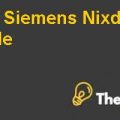
Integration of NSI- Continue as stand alone or integrated into LM’s operations
This is a very important area to discuss in an acquisition process because some of the big corporate failures resulted not because the company’s were not capable enough but because they failed to integrate. Employees are the core assets of the organization which enable the company to achieve the long-term mission of the company, so a critical analysis is required about the organization’s structure and reporting style when considering integration.
If NSI is acquired, the most important aspect of acquisition is whether to integrate NSI into LM structure or not. Both the companies have similar values along with strong commitment to quality and customer service. On the other hand, cultural compatibility is another issue because NSI operates a flat and de-centralized organization that allows it to respond quickly to customer queries whereas LM has a traditional and complex reporting structure with a formal set of policies, procedures and well-documented process to maintain control. Both the companies have similar values but a different organizational structure which may cause hurdles in integration.
Weighted Average Cost of Capital (WACC) and Discounted Cash Flow (DCF)
Different assumptions have been carried out in Exhibit 2 and Exhibit 3 for calculating Weighted Average Cost of Capital (WACC) and DCF. Our analysis in Exhibit 2, based on different assumptions shows that the company has a WACC of 5%.
The company has already an attractive net profit margin and the free cash flows are continuously increasing, which made a total sum of $233.512 and a terminal value of $1,300.91. These free cash flows and terminal value are discounted at the company’s cost of capital that results in an equity value of $1,182.99.
Following assumptions have been made for determining WACC and DCF:
- A 25% increase in revenue after 2008.
- Perpetual growth is assumed to be 1% per annum for long-term growth.
- Beta is used as an average of all NSI comparables.
- Bond rating is assumed at a 10 years government rate, which is assumed to use a medium bond rating.
- Changes in EBIT are assumed at an average of prior years.
- The depreciation and amortization will remain constant over years.
- Changes in capital expenditure are assumed at an average of prior years.
- Changes in working capital are assumed at an average of prior years.
NSI valuation using multiple valuation techniques
Our analysis in Exhibit 5 shows that the net-book value of NSI is $69.24 million and the DCF results a total of $1,182.99. It is clear from the analysis that different valuation techniques are required to estimate the most approximate fair value of the company
Therefore, valuation techniques are used to estimate the value of NSI. Among the recent acquisitions in the industry, the acquisition of DRS seems reasonable because it is the most recent transaction as well as DRS has high EBIT, EBITDA margin.
Using the DRS Multiples, it provides a valuation ranging from 978.02 million to 1,043.93 million, whereas the average of the multiples shows a result of $1,010.47 million. Further comparison has been made for 3 most recent transactions which show an average result of $649.46 million.
LM offer price if it desire to acquire NSI
Acquisition is always a critical issue, especially the organization faces difficulty in valuation. So in order to facilitate better valuation, we obtained an average of different valuation techniques which include:
- Book-Value Equity
- DCF Method
- Multiple Analysis
|
Valuation Techniques |
$ in million |
| NSI- Book value of equity |
69.24 |
| NSI- Valuation using DCF |
1,182.99 |
| NSI- Average valuation on DRS multiples |
1,010.47
|
| NSI- Average valuation on recent acquisition multiples |
649.46
|
| Average of all valuations |
728 |
The average method adopted will reduce chances of error and allow us to best estimate the value of the entity so we recommend that the price should not be more than $728 million.
Although our analysis using DCF method shows a substantial difference as compared to other analysis, this might be due to different assumptions that are used about future cash flows, cost of capital, etc.
Value of potential synergies from the acquisition
The acquisition of NSI will provide Lockheed Martin greater diversity in its defense operations because the company was working on many contracts by the U.S. Army, U.S. Navy, U.S. Air Force and USAID that worth from $200 million to $1.5 billion.
Further, NSI is expected to generate revenue from over sixty significant on-going contracts and task orders, which will increase the worth of both the organizations and provides an opportunity to Lockheed Martin to exploit further by achieving strategic growth through cross-selling its product to NSI’s client.............................................
This is just a sample partial case solution. Please place the order on the website to order your own originally done case solution.












